
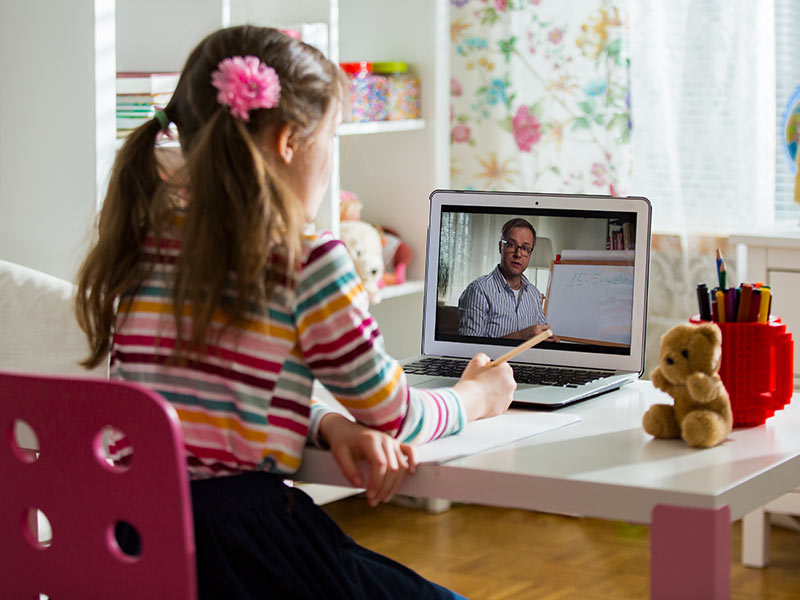
The school year approaches. Some districts have already communicated the specifics of what your child’s day is going to look like, and for the majority of us, it looks like our homes will double as school rooms for the next few months (at least).
So what now?
We’re glad you asked. Here’s what we’re doing to prep our families.
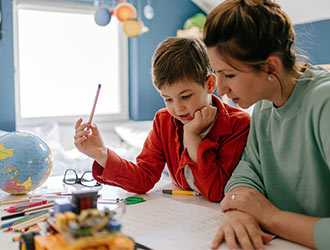 1. Create a dedicated learning space.
1. Create a dedicated learning space.Find a space where the kids can focus, but get your attention if need be. We’re biting the bullet and converting half of our living room into a learning zone.
If you’re working with a smaller space, find the spot where quiet, good lighting and the least distractions intersect. Set up a card table or pull in a small one from another room. The goal is to create a spot where they can come to every day and be comfortable learning.
We’re also adding a small whiteboard which we’ll use to demonstrate math or other concepts, write on-deck activities, or doodle between assignments.
Keeping things tidy is also important to reduce distraction and simply know where things are the next time you need them. With that in mind, clear a bookshelf, some drawers, or buy easy to open containers for their supplies and, thereby, a portion of your sanity.
Of course, things like pencils and erasers will likely stay out perennially, but art supplies and ongoing assignments stay cleaner and in better shape if they can get consistently stored when not in use.
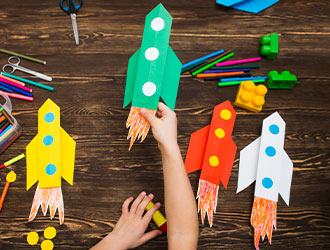 2. Enlist the kids to make their space fun
2. Enlist the kids to make their space fun
We found this spring that getting our kids involved in the process increased their buy-in on using the space consistently.
For the fall we’re having them create personalized wall art. Our youngest is drawing the ABCs which we’ll hang on the walls. We’ve also gathered old magazines that can be cut up and refashioned into collages. We’re asking ours to make one of whatever they want, likely cats and super heroes, and one that’s about the things they like about school. They haven’t started the latter one yet, but we are anticipating that our eldest will try to fill it with images of lunch and recess.
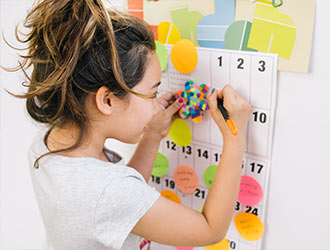 3. Tailor to your child whenever possible.
3. Tailor to your child whenever possible.
A big part of helping your children learn is understanding their personality. My soon-to-be second grader had a terrible time last year trying to concentrate on some tasks for longer than 30 minutes outside of the classroom environment. To combat that, we laid out a schedule that took this into account and even involved him in creating the schedule so he felt some agency and control amidst the early chaos.
While this fall looks to be much more structured, with more time receiving direct instruction by an educator, you should never hesitate to go to your child’s teacher to communicate any learning trouble your family is experiencing.
Educators with which I’ve interacted understand distance learning, especially for smaller children, can be an incredible challenge and are open to finding ways to work with us to get the best from our students.
Also keep in mind that transition to school in the fall, pandemic or no, is usually a stressful time for kids, so take that into account when you find your child acting out a bit more, being tired earlier in the day, or reacting more dramatically to stressful situations.
 4. Let sleeping children lie.
4. Let sleeping children lie.
Take advantage of at-home learning by letting your kid sleep in. Researchers indicate that many of our children are chronically sleep-deprived. Teens especially have biologically linked reasons for needing extra hours or an extended sleep schedule.
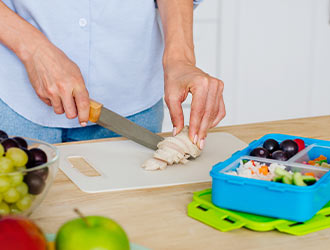 5. Pack lunches!
5. Pack lunches!
Reinforce your schedule with regular lunch-time and pre-packed lunches. Our process includes having the kids help make and pull together the majority of the lunch elements and then sneak in a fun something before going to bed.
Silver lining: Parents who have kiddos with food allergies can rest easy with at-home lunching. On the flip side, parents lucky enough to not have to deal with peanut or other allergies can take advantage of the situation to bring back the classic school lunch staple. Also, kids who like off-beat or stinky foods can now have them without bothering or being teased by classmates. Microwaved fish anyone?
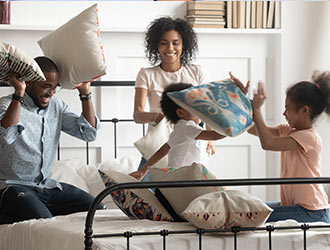 6. Maintain your modeling career, but don’t beat yourself up.
6. Maintain your modeling career, but don’t beat yourself up.
It’s important to do what you can to demonstrate the behavior you want to see from your kids. Honestly, it’s good for both of you.
I certainly can’t speak for everyone, but I know that without a commute into the office and regular outings to the grocery store, or any store for that matter, our family has had to actively decide to do the things on the list below:
-Take breaks
-Get plenty of sleep
-Exercise
-Eat well
-Stay socially connected
Before the pandemic, most if not all of these things were naturally built into the course of our day. Gatherings at the proverbial water cooler, chats with teachers and other parents during pick-up, all the steps we got in running errands and chauffeuring to extracurriculars. These daily activities checked off so many boxes that can now easily be left empty if we let them. This is why it becomes more important than ever to make that effort.
That being said we’re living in a stressful, quickly changing landscape. It’s a waste of your energy and further damaging to your physical and mental well being to beat yourself up over any inability to meet unreasonable goals and expectations.
Need a breather? Don’t feel guilty about giving your kids a bit of extra screen time while you finish off your workday, or step away from everything to relax and unwind for a minute. Or thirty.
Always remember that your mental and physical well being is critical. I find it helpful to ask myself ‘what would you do if someone asked your kid to…’. If the answer includes G and T’s neighbors, or “Who ask you to do that? Don’t worry I’ll have a talk with them”, then why would you do it to yourself if you have the option not to?
- Work through breaks?
- Skip lunch?
- Losing valuable sleep to get something done, but then be super unproductive the next day as a result?
- Skip exercise in favor of screen time?
I get it. Sometimes it’s easier to give advice than to take it. But. If we’ve learned anything at all from the oxygen mask portion of pre-flight videos, you have to help yourself to be in a position to effectively help others.
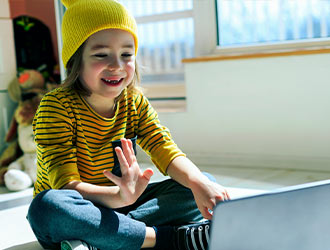 7. Stay Social
7. Stay Social
Explore opportunities for your child to connect with friends and classmates —either virtually or in person, while maintaining physical distance.
They’ll need to participate in classes and interact with their peers virtually in the fall, so why not ramp up beforehand in a lower stake situation.
8. The internet is your friend.
Don’t forget that you can Google or YouTube anything. If you are looking for specific resources for any specialized learning situation. There are examples and resources out there and they’re at your fingertips.
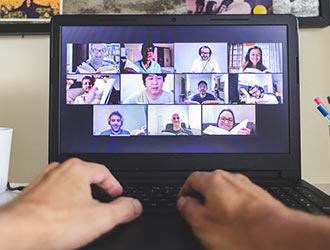 9. Lean on your community.
9. Lean on your community.
If available, take advantage of parents groups on FB, both for your student’s grade level and class when assignments are final. They provide a great forum to get advice, provide what works for you, and simply connect with a group of people in your community that is going through many of the ups and downs you are.
If you are experiencing financial hardships or sitting on extras of anything, look into neighborhood-based organizations like the Buy Nothing Project. For the unfamiliar, Buy Nothing promotes local gifting economies largely managed through Facebook Groups. No selling or trading. Just giving.
Have your kids outgrown clothes, toys or bikes? Post them to the group as gifts to your community. Running short on funds for school supplies? Request pencils, pens, or other necessities from the group. In my experience, most requests are fulfilled at least in part. Around school time, there are normally organized kid’s clothing swaps. I’ve also found it a great resource for items that you (hopefully) don’t need in the long term, like crutches, or may only use once, or at best, infrequently, like puzzles and books.
Please keep in mind, due to the pandemic, some groups have defaulted to ‘essential’ items only. Even so, it’s a great way to connect with people in your neighborhood, especially if you are new to the area.
We hope our ideas help you and your family to establish a comfortable routine for your whole family.
Did you find this article helpful? Please share it with your friends!



